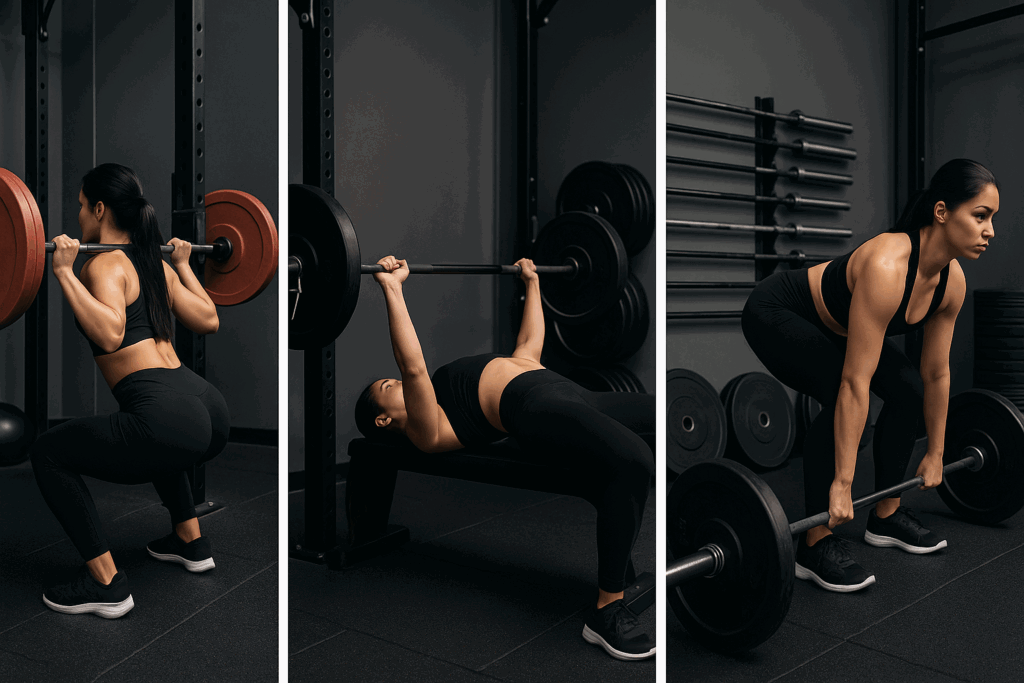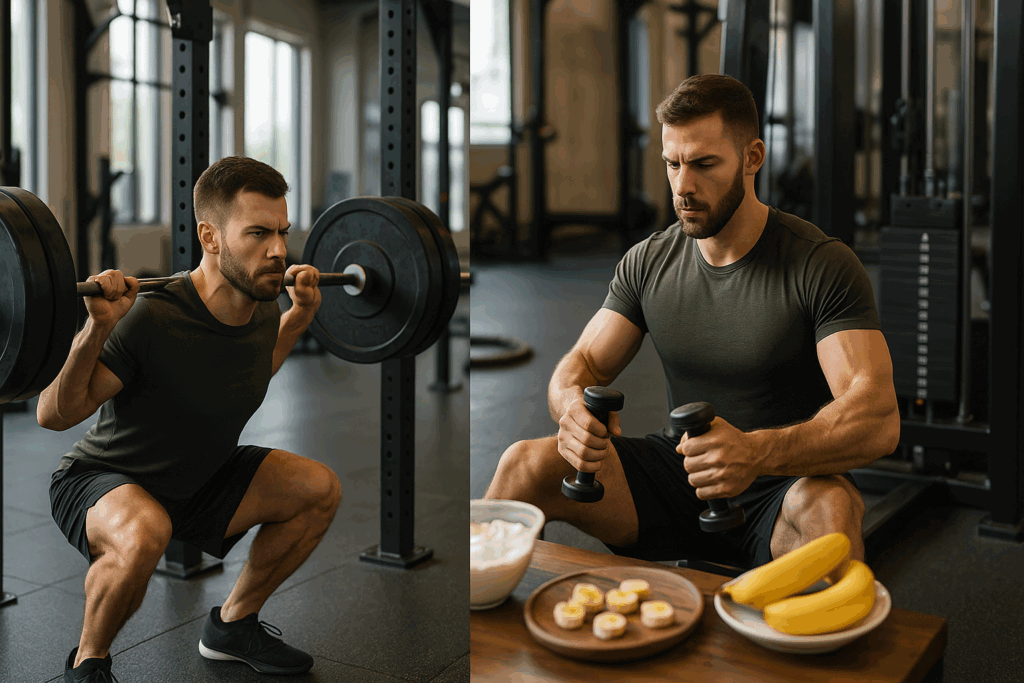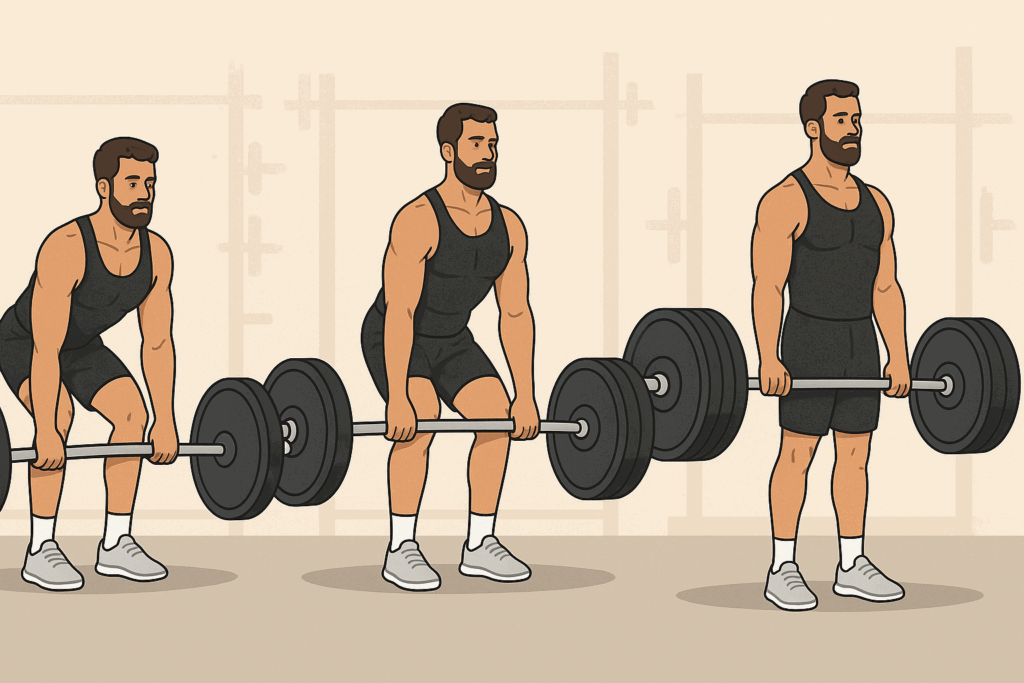Redefining Strength: The Purpose of a Powerlifting Program Template
Building strength is more than just lifting heavy—it’s about consistency, periodization, recovery, and intelligent progression. In strength sports like powerlifting, a well-structured program is the linchpin between stagnation and measurable gains. A powerlifting program template offers a strategic framework that balances volume, intensity, frequency, and recovery. By mapping out progression across the squat, bench press, and deadlift, lifters can avoid plateaus and optimize muscular development. The purpose of this guide is to break down the essential elements of crafting a personalized, high-performance powerlifting program template that aligns with your experience level, training frequency, and long-term goals.
The core lifts in powerlifting—squat, bench press, and deadlift—are full-body compound movements that demand neurological adaptation and muscular synergy. Unlike general bodybuilding routines, which prioritize hypertrophy through volume and isolation, a powerlifting bodybuilding program must also address neuromuscular efficiency, joint resilience, and maximum force output. When planned correctly, a powerlifting program template will not only help you add plates to the bar but also enhance your overall athletic potential.
This comprehensive article will delve into the critical variables of strength training, including periodization models, assistance work, rest strategies, and real-world applications. Whether you’re following free powerlifting programs or developing a customized routine, this resource will provide the depth, context, and tactical insight needed to elevate your lifting and ensure long-term progress.
You may also like: The Ultimate High-Protein Meal Plan for Weight Loss and Muscle Gain Backed by Science
Foundational Concepts in Powerlifting Program Design
Before diving into the specifics of a powerlifting program template, it is important to understand the foundational pillars of programming. These include training specificity, progressive overload, recovery management, and adaptive periodization. Training specificity ensures your exercises and modalities directly enhance the three main lifts. While novice lifters might experience general strength gains from nearly any resistance training, intermediate and advanced athletes require high-specificity programs to yield continued progress.
Progressive overload, the cornerstone of all resistance training, involves gradually increasing training demands to elicit adaptation. This can be achieved through heavier weights, increased volume, higher frequency, or reduced rest intervals. However, overload must be balanced with adequate recovery, as the nervous system, connective tissues, and musculature all have distinct recovery timelines. A well-structured powerlifting program template incorporates deloads and autoregulated sessions to prevent overtraining and maintain performance.
Periodization—the planned variation in training variables—guides progression over time. Linear periodization is popular among beginners due to its simplicity, while undulating and block periodization offer advanced athletes more targeted adaptations. Understanding which model suits your current training phase is crucial to maximizing results and minimizing risk. These principles, when applied with intention, transform random training sessions into a synergistic journey toward peak strength.

Core Lifts and the Role of Technical Mastery
Any effective powerlifting program template must revolve around mastering the squat, bench press, and deadlift. Each lift involves multiple muscle groups, technical checkpoints, and coordination patterns. As such, success in powerlifting depends not just on brute strength but on skill acquisition and technical refinement.
Squats require proper mobility in the hips and ankles, core stability, and spinal alignment. Variations like high-bar and low-bar squats have different loading patterns and emphasize different muscle groups. Regular video analysis, coaching feedback, and technique drills can help lifters identify and correct inefficiencies. For example, lifters struggling with forward lean in the squat may benefit from paused squats or tempo work to develop positional strength.
The bench press emphasizes upper body pushing strength but also demands shoulder stability, arch control, and precise bar path mechanics. Overuse injuries in the shoulders and elbows are common when technique or volume is poorly managed. Proper programming includes variations like close-grip bench, floor press, and slingshot bench to target sticking points and prevent overuse.
Deadlifts test posterior chain strength and grip endurance. They are often the most neurologically taxing of the three lifts, requiring longer recovery times. Conventional, sumo, and trap bar variations provide different mechanical demands. Emphasizing setup consistency, bracing, and hip-hinge patterning improves force output and injury resilience.
The synergy between these three lifts creates a complete foundation for strength development. Rather than training them in isolation, a powerlifting bodybuilding program incorporates assistance work, mobility protocols, and recovery tools that enhance movement quality and load tolerance over time.

Building a Weekly Powerlifting Program Template
Constructing a weekly powerlifting program template requires balancing specificity with recovery. A common format is the four-day split: two upper-body sessions and two lower-body sessions, often divided into heavy and volume-focused days. For example, a Monday heavy squat and deadlift session may be followed by Thursday volume work, while Tuesday and Friday might be devoted to heavy and volume bench press variants, respectively.
Each training day should begin with a primary lift performed for low to moderate reps (typically 3–6) at high intensity. This is followed by secondary lifts that reinforce movement patterns, such as front squats after back squats or incline bench after flat bench. Accessory movements—such as rows, pull-throughs, and hamstring curls—target weak points, enhance muscular balance, and promote hypertrophy.
Recovery days must be strategically placed to avoid systemic fatigue. For example, placing deadlifts the day before squats may impair performance due to overlapping motor unit fatigue. Intelligent sequencing enhances performance across the week. Tools like RPE (Rate of Perceived Exertion) and velocity-based training can further guide intensity selection and autoregulation.
Flexibility is also key. For athletes balancing work or family obligations, a three-day template may be more sustainable. Conversely, highly competitive lifters may benefit from five or six training days with micro-cycle variation. The ultimate goal is to maintain adherence, manage fatigue, and ensure consistent technical execution over time.

Integrating Hypertrophy in a Powerlifting Bodybuilding Program
Combining maximal strength development with hypertrophy requires a nuanced approach. While powerlifters do not train like traditional bodybuilders, the hypertrophic adaptations from higher volume and moderate intensity work are essential for building the muscular base needed to lift heavier weights. This hybrid approach is often referred to as a powerlifting bodybuilding program.
Accessory movements should be selected to target muscle groups that contribute directly to the big three lifts. For example, triceps hypertrophy supports lockout strength in the bench press, while upper back development stabilizes the squat and deadlift. These movements are typically trained in the 8–15 rep range using moderate loads, short rest intervals, and controlled tempos.
Incorporating hypertrophy-focused blocks within your periodized powerlifting program template allows for muscle growth during lower-intensity phases. This strategy not only builds size but provides a mental break from the rigors of maximal lifting. Periods of higher rep training improve joint health, tissue resilience, and movement quality.
Many free powerlifting programs overlook this essential element, focusing exclusively on intensity at the expense of long-term progression. A well-rounded program includes dedicated hypertrophy sessions, emphasizing movement variation, pump-focused techniques, and metabolic stress—all while reinforcing the movement patterns that underlie your core lifts.

Programming Progression: How to Advance Your Powerlifting Template
Progression is the heartbeat of strength training. In any powerlifting program template, advancing load, volume, or technical mastery over time ensures that training remains effective and avoids stagnation. One proven model is linear progression, in which the load increases each week while volume remains constant. This is highly effective for novice lifters due to their rapid adaptation rates.
Intermediate lifters benefit more from undulating or block periodization. Undulating periodization involves fluctuating volume and intensity across the week—e.g., Monday (heavy), Wednesday (moderate), Friday (light)—to stimulate different adaptations. Block periodization divides training into mesocycles focusing on hypertrophy, strength, and peaking phases, enabling targeted development while managing cumulative fatigue.
Tracking performance data is essential. Whether through training logs, velocity tracking, or subjective metrics like RPE and sleep quality, consistent monitoring helps lifters identify trends and adjust programming accordingly. Recovery indicators—such as morning heart rate, grip strength, or session motivation—guide deload timing and training load adjustments.
Advanced lifters may introduce specialized techniques such as wave loading, contrast training, and isometric holds to break through plateaus. These methods add neural complexity and vary the stimulus while maintaining movement specificity. The key is to apply new stimuli purposefully, with a clear understanding of how each adjustment fits into your broader training timeline.

Adapting a Powerlifting Program Template for Individual Goals
No two lifters are the same. A template must be adaptable to account for differences in training history, limb proportions, lifestyle constraints, and competition timelines. This personalization distinguishes elite programming from generic free powerlifting programs.
For instance, taller lifters may struggle with deadlift leverages and require additional hamstring and glute development. Lifters with long arms might bench less efficiently and benefit from increased triceps and pec accessory work. Similarly, individuals returning from injury must reduce volume and rebuild motor patterns through tempo work, isometrics, and limited ROM exercises.
Lifestyle variables matter as well. Those with high-stress jobs or limited sleep may require reduced frequency or altered intensity. Female athletes may benefit from higher volume and shorter rest intervals due to different hormonal recovery patterns. The more a powerlifting program template accounts for individual needs, the more effective it becomes.
Competition timelines also shape programming. Peaking phases should be planned around meet dates, tapering intensity while maintaining bar speed and movement quality. During off-seasons, lifters can focus on hypertrophy, mobility, and weak point development to set the foundation for future strength phases. A dynamic, athlete-centered approach ensures continuous progression and reduces injury risk.
Recovery, Mobility, and Injury Prevention in Powerlifting
Strength is built in the gym, but progress is solidified through recovery. Sleep, nutrition, hydration, and active recovery practices all play critical roles in maximizing adaptation. A powerlifting program template must integrate recovery strategies, not as afterthoughts but as essential programming elements.
Mobility work—targeting hips, ankles, thoracic spine, and shoulders—enhances joint positioning and reduces compensatory patterns. Pre-session activation drills, such as glute bridges and banded pull-aparts, reinforce optimal motor recruitment. Post-training soft tissue work and stretching facilitate recovery by improving circulation and reducing neural tension.
Nutrition supports tissue repair and hormonal balance. Adequate protein intake (typically 1.6–2.2g/kg body weight), strategic carbohydrate timing, and micronutrient density enhance performance and recovery. Hydration, often overlooked, influences muscular contraction, temperature regulation, and fatigue perception.
Sleep is perhaps the most critical variable. Seven to nine hours of high-quality sleep supports growth hormone production, neural repair, and mood regulation. For lifters experiencing chronic soreness or stagnation, sleep improvement often yields better results than programming changes alone. An elite-level program acknowledges that adaptation is a 24-hour process.

How to Customize Free Powerlifting Programs to Fit Your Needs
Many free powerlifting programs offer excellent starting points but lack personalization. Customizing these programs involves modifying frequency, exercise selection, and recovery tools to better align with your lifestyle and biomechanics. Start by assessing whether the default weekly structure fits your schedule. If a program requires five days in the gym and you can only train three, condense sessions by pairing movements and reducing non-essential accessories.
Evaluate the exercise list critically. If front squats aggravate your knees, substitute safety bar squats or leg press variations. If your bench stalls at lockout, consider incorporating board presses or band-resisted reps. The goal is to maintain the spirit of the program while enhancing individual compatibility.
Recovery customization is also vital. Incorporate deload weeks based on biofeedback rather than fixed intervals. Adjust volume upward or downward depending on energy levels, stress, and performance trends. Many free templates use fixed percentages, but substituting RPE or bar speed thresholds allows for better autoregulation.
Finally, track progress with intention. Modify programs proactively rather than reactively, using trends and performance data to guide changes. Over time, this transforms a one-size-fits-all approach into a highly refined strength-building protocol that evolves with your development.
The Long-Term Value of a Periodized Powerlifting Program Template
In the realm of strength development, sustainability trumps short-term intensity. The most effective powerlifting program template is one that evolves across years—not just weeks. Periodization allows for ebbs and flows in volume, intensity, and focus, preventing burnout while fostering consistent growth.
Long-term programming teaches lifters how to listen to their bodies, respond to setbacks, and embrace the cyclic nature of progress. Instead of chasing weekly PRs, lifters learn to appreciate the macro view—how today’s session fits into a 16-week block, how this year’s work lays the foundation for next year’s potential.
This mindset shift fosters resilience, accountability, and maturity. Athletes become less reactive and more strategic, building training habits that last a lifetime. Lifters who internalize this approach are more likely to avoid injury, maintain enthusiasm, and achieve milestones others only dream of.
By adhering to a dynamic, science-based powerlifting program template, lifters unlock a trajectory of continual improvement. They become students of the sport, refining not just their strength but their philosophy of training.
Frequently Asked Questions: Powerlifting Program Template for Maximum Gains
1. How Do I Choose the Right Powerlifting Program Template for My Experience Level?
Selecting the appropriate powerlifting program template depends heavily on your training history, goals, and recovery capacity. Beginners often benefit from linear progression templates that prioritize simplicity and frequency, allowing for rapid strength gains through consistent exposure to the big three lifts. Intermediate lifters may require periodized templates with built-in deloads and rotating intensities to continue progressing without overtraining. Advanced athletes, meanwhile, benefit most from high-specificity templates that manipulate volume and intensity in complex ways, including autoregulation and weekly undulations. If you’re unsure where to begin, reviewing free powerlifting programs online tailored to your lifting background can provide a helpful foundation before committing to a customized approach.
2. Can a Powerlifting Program Template Be Adapted for Bodybuilding Goals?
Yes, hybridizing a powerlifting program template with a bodybuilding focus is not only possible—it’s a growing trend among strength athletes. The key lies in prioritizing compound movements like squats, deadlifts, and bench presses for strength while supplementing your routine with hypertrophy-based accessories. This powerlifting bodybuilding program hybrid allows for neural adaptations from heavy lifts and muscular development through higher-rep accessory work. Techniques like rest-pause, tempo variations, and supersets can be layered into the template without compromising its core integrity. Over time, this dual-purpose approach leads to impressive gains in both strength and physique.
3. What Are the Main Differences Between Free Powerlifting Programs and Custom Templates?
Free powerlifting programs offer accessibility and standardization, making them a valuable resource for beginners and intermediate lifters seeking structured guidance. However, they often lack the nuance necessary to accommodate individual biomechanics, recovery rates, and lifestyle constraints. A custom powerlifting program template, on the other hand, takes into account fatigue management, movement weaknesses, and personal training history to optimize results. For athletes with advanced needs, investing in a personalized program—whether through a coach or advanced software—can drastically improve performance longevity. Free programs can serve as a useful baseline, but they should eventually be adapted to address specific limitations and goals.
4. How Often Should a Powerlifting Program Template Be Updated?
It’s recommended to revisit and adjust your powerlifting program template every 8 to 12 weeks depending on your progress, recovery, and any plateaus. Adaptation to training stimuli naturally leads to diminishing returns over time, which necessitates changes in volume, intensity, and exercise selection. Advanced lifters might even benefit from changing templates more frequently to address evolving weaknesses or prepare for competition cycles. Updating the template ensures progressive overload remains effective while also preventing psychological fatigue from monotonous routines. Regular testing of one-rep maxes or estimated maxes is a good checkpoint to assess whether a new template phase is warranted.
5. What Metrics Should I Track to Evaluate a Powerlifting Program Template’s Effectiveness?
Beyond just improvements in your one-rep max, evaluating a powerlifting program template should include metrics such as bar speed, perceived exertion, recovery quality, and consistency of training sessions. Keeping a training journal with weekly summaries helps identify trends in motivation, soreness, and technical proficiency across the squat, bench, and deadlift. You should also monitor accessory movements to see if they’re addressing weak points effectively. If progress stalls despite adequate nutrition and sleep, this could indicate the template needs modification in volume or frequency. Ultimately, data-backed decision-making leads to smarter training and reduced injury risk.
6. How Do I Balance Recovery While Using an Intense Powerlifting Bodybuilding Program?
Combining strength and hypertrophy work in a single plan can lead to central nervous system fatigue if recovery isn’t prioritized. Adequate sleep, nutrition rich in micronutrients and macronutrients, and programmed deload weeks are crucial for sustainability. Using a powerlifting bodybuilding program requires attentive management of training variables such as exercise selection, load intensity, and weekly training volume. Recovery tools like massage therapy, contrast showers, and active recovery sessions can also accelerate tissue repair and energy restoration. Monitoring your heart rate variability or resting heart rate trends can provide early warnings of overtraining.
7. Can You Use a Powerlifting Program Template Without Competing?
Absolutely. Many individuals use a powerlifting program template to improve strength, mental discipline, and body composition without ever stepping onto a competitive platform. These templates are effective for functional strength development and long-term musculoskeletal health. The structured nature of powerlifting plans teaches goal setting, progress tracking, and exercise mastery, all of which benefit general fitness and longevity. For recreational lifters, modifying the intensity range and reducing peak specificity can still yield impressive results without the pressure of performance deadlines. Moreover, these templates are adaptable enough to integrate with other training modalities, like CrossFit or martial arts.
8. What Are Common Mistakes to Avoid in Free Powerlifting Programs?
While free powerlifting programs offer convenience, common pitfalls include neglecting warm-up routines, overlooking mobility work, and failing to individualize accessory movements. Many lifters blindly follow percentages without accounting for daily readiness or prior injuries. Overemphasis on maxing out can lead to form breakdowns and recovery deficits. To maximize benefit, athletes should contextualize any free template by monitoring their own fatigue, incorporating movement prep, and adjusting rest days based on energy levels. It’s also wise to periodize deloads and reassess the program’s fit every few weeks.
9. How Do Powerlifting Program Templates Differ by Training Age?
Novice templates focus on frequency, high practice volume, and progressive overload across sessions. Intermediate lifters transition to more nuanced structures, incorporating weekly periodization and alternating intensity zones. Advanced templates often leverage block periodization, undulating models, and autoregulated volume schemes to account for accumulated fatigue and marginal gains. A powerlifting program template should evolve with your training maturity, ensuring new stimuli are introduced to elicit continued adaptation. The longer you’ve trained, the more important it becomes to individualize every aspect—from rest intervals to movement sequencing.
10. Can a Powerlifting Program Template Be Periodized for Long-Term Success?
Yes, long-term success hinges on effective periodization within any powerlifting program template. Strategic planning across macrocycles (yearly), mesocycles (monthly), and microcycles (weekly) helps balance stress and recovery while targeting specific performance goals. Block periodization, conjugate methods, and daily undulating periodization are all viable strategies for structuring training phases. These frameworks allow athletes to focus on hypertrophy, strength, and peaking sequentially or simultaneously. Periodization ensures that each cycle builds upon the previous one, reducing the risk of stagnation and overtraining while amplifying long-term gains.
Conclusion: Creating Strength That Lasts
Mastering strength is as much about strategy as it is about effort. A well-designed powerlifting program template is your roadmap to sustainable gains, technical precision, and athletic longevity. By understanding the principles of periodization, progressive overload, recovery, and customization, lifters can craft programs that evolve with their needs and maximize results.
From the integration of hypertrophy phases in a powerlifting bodybuilding program to the intelligent application of free powerlifting programs, each choice plays a role in shaping your performance and reducing injury risk. The journey of strength is a marathon, not a sprint—and those who succeed are those who plan with purpose, train with intention, and recover with discipline.
Ultimately, the power of any program lies not just in its structure, but in how it’s executed. Let this be the foundation of your approach—a template not just for stronger lifts, but for a stronger life.





